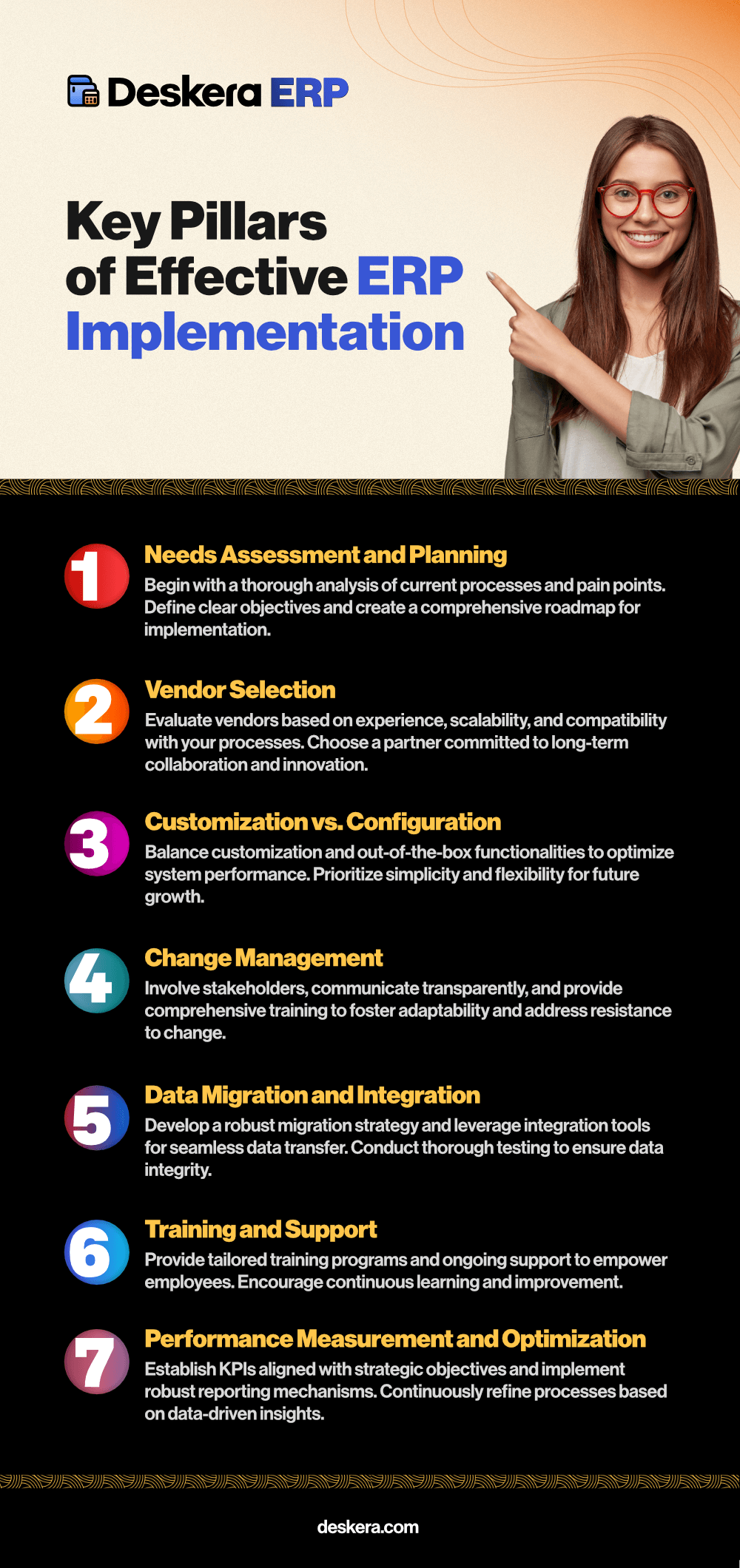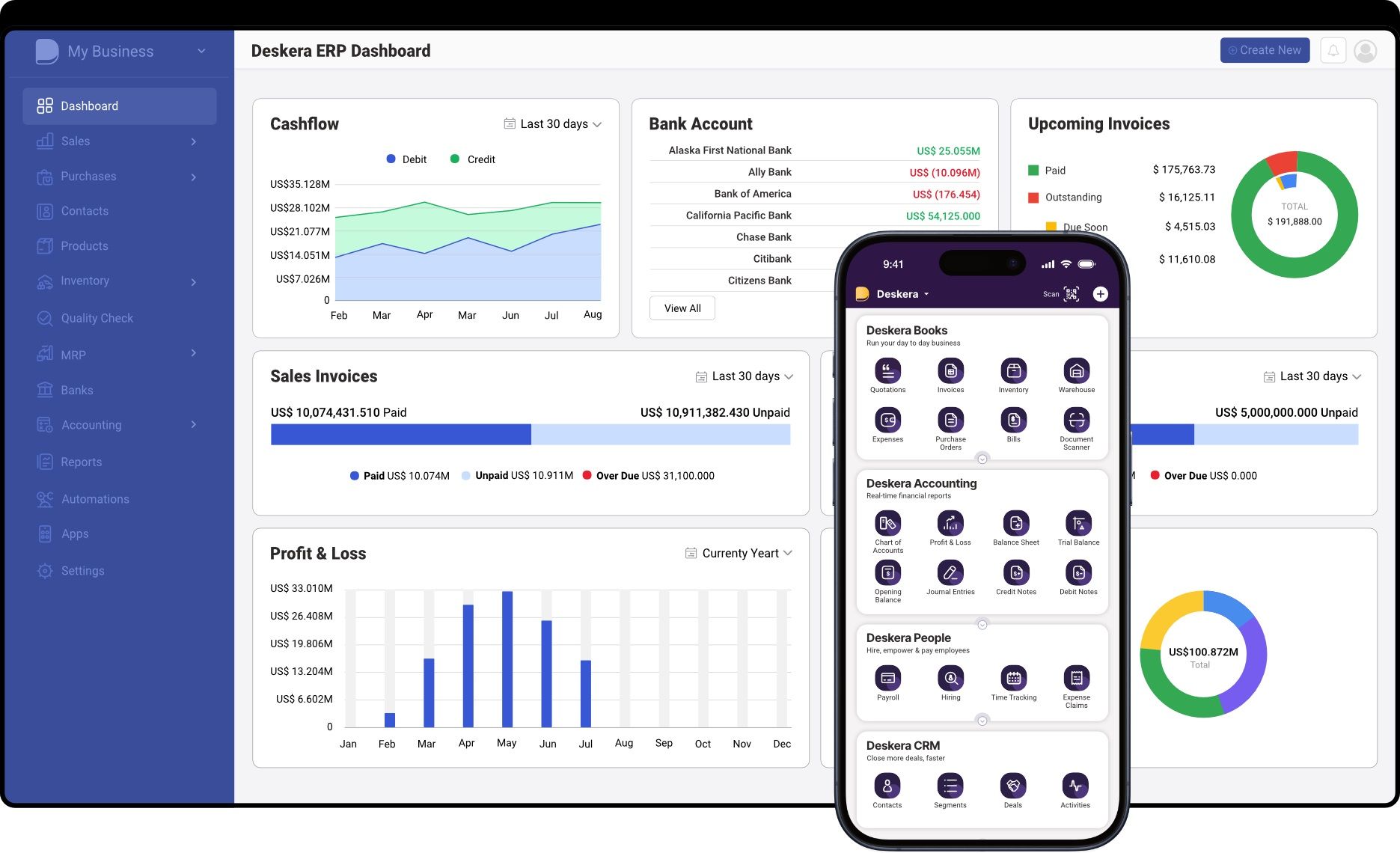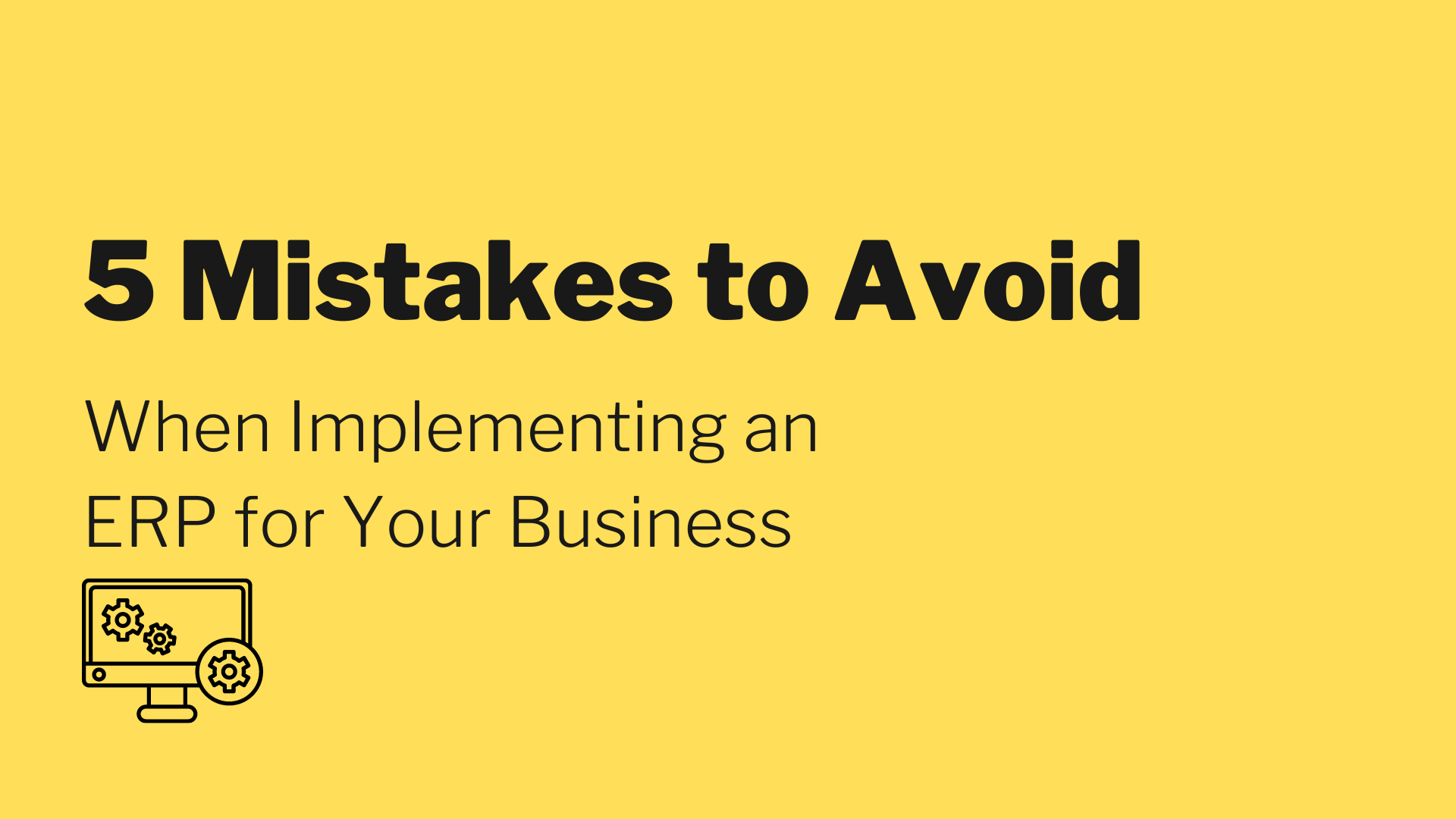Studies revealed that 51.1% of organizations improved most business processes with their ERP investments. The same study also found that 85.5% of companies got improved productivity and efficiency with their ERP implementation. However, to ensure this, it is crucial to correctly carry out ERP system implementation.
In the rapidly evolving landscape of modern business, where efficiency, integration, and data-driven decision-making reign supreme, ERP systems stand as indispensable tools for organizations seeking sustainable growth and competitive advantage.
ERP implementation, however, is not merely a technological upgrade but a transformative journey that touches every facet of an enterprise, from operations to strategy.

In this dynamic landscape, Deskera emerges as a prominent player, offering comprehensive ERP solutions tailored to diverse business needs. With Deskera's innovative approach, organizations can streamline processes, enhance efficiency, and drive strategic growth through seamless ERP implementation.
By leveraging Deskera ERP's expertise and cutting-edge technology, businesses can navigate the complexities of ERP implementation with confidence, maximizing ROI and achieving sustainable success in today's competitive environment.
This comprehensive guide aims to demystify the complexities surrounding ERP implementation, offering a roadmap for businesses embarking on this transformative endeavor.
Whether you're a small startup or a multinational corporation, the principles outlined herein provide actionable insights to navigate the challenges and harness the full potential of ERP systems.
What is ERP Implementation?
ERP implementation refers to the process of deploying and integrating Enterprise Resource Planning (ERP) software within an organization's operations to streamline business processes, enhance efficiency, and improve decision-making capabilities.
It involves various stages, including planning, system configuration, data migration, training, and ongoing support, aimed at aligning the ERP system with the organization's goals and requirements.
ERP implementation is a complex undertaking that requires careful analysis, stakeholder involvement, and effective change management to ensure successful adoption and realization of anticipated benefits.
Risks of Not Implementing an ERP System
The risks of not implementing an ERP solution extend across various aspects of organizational operations, affecting efficiency, effectiveness, and competitiveness.
Not implementing an ERP solution exposes organizations to several risks that can impede their growth and competitiveness:
Inefficiency and Disconnected Processes
Without an ERP system, organizations often rely on disparate systems and manual processes, leading to inefficiencies, data silos, and duplication of efforts. This lack of integration hampers productivity and inhibits informed decision-making.
Limited Visibility and Decision-Making
The absence of an ERP solution results in fragmented data and limited visibility into organizational operations. This makes it challenging for management to access real-time insights and make data-driven decisions, leading to missed opportunities and suboptimal outcomes.
Inaccurate and Incomplete Data
Manual data entry and disparate systems increase the risk of errors, inaccuracies, and inconsistencies in data. Without a centralized database and data governance framework, organizations struggle to maintain data integrity and trustworthiness.
Ineffective Resource Utilization
Without the automation and optimization capabilities offered by an ERP system, organizations may struggle to allocate resources efficiently. This can lead to underutilization of assets, overstaffing in certain areas, and inefficient inventory management.
Limited Scalability and Growth
Manual processes and disparate systems hinder scalability, making it difficult for organizations to adapt to changing business needs and scale their operations effectively. This limits growth opportunities and impedes competitiveness in dynamic markets.
Compliance and Regulatory Risks
Without robust ERP controls and audit trails, organizations face increased compliance risks and may struggle to meet regulatory requirements. This exposes them to potential fines, legal liabilities, and reputational damage.
Customer Dissatisfaction
Inefficient processes and poor data management can result in delays, errors, and inconsistencies in customer interactions. This can lead to decreased customer satisfaction, loss of business, and damage to brand reputation.
High Operational Costs
Manual processes and disparate systems incur higher operational costs due to inefficiencies, labor-intensive tasks, and increased risk of errors and rework. This negatively impacts profitability and competitive positioning.
Key Pillars of Effective ERP Implementation
Effective ERP implementation hinges upon addressing key pillars with a holistic approach and adopting a phased strategy. By doing so, businesses can proactively mitigate risks, minimize disruptions, and unlock the full potential of ERP systems to fuel organizational growth, foster agility, and inspire innovation.

Needs Assessment and Planning
Understanding the unique requirements of your organization is the cornerstone of successful ERP implementation. Begin by conducting a thorough analysis of your current processes, identifying pain points, and envisioning the desired future state.
Define clear objectives that align with your business goals and translate them into actionable strategies. Formulate a comprehensive roadmap that outlines the steps to be taken, timelines, and resource allocation, ensuring alignment with your organization's vision and values.
Vendor Selection
Selecting the right ERP vendor is a critical decision that can significantly impact the success of your implementation. Evaluate potential vendors based on factors such as their industry experience, track record of successful implementations, scalability of their solutions, and compatibility with your business processes.
Assess their capabilities, including system functionalities, technical support, and implementation methodology. Choose a vendor that not only meets your immediate requirements but also demonstrates a commitment to long-term partnership and innovation.
Customization vs. Configuration
Strike the right balance between customization and configuration to optimize system performance and minimize post-implementation challenges.
While customization allows you to tailor the ERP system to your specific needs, excessive customization can lead to complexity, increased costs, and maintenance issues.
Leverage out-of-the-box functionalities wherever possible and reserve customization for unique business processes that provide a competitive advantage.
Prioritize simplicity and flexibility to accommodate future growth and changes in business requirements.
Change Management
Successfully navigating the human aspect of ERP implementation is essential for driving organizational buy-in and mitigating resistance to change.
Cultivate a culture of adaptability by involving key stakeholders from the outset and communicating transparently about the rationale behind the ERP initiative.
Provide comprehensive training and support to empower employees with the skills and knowledge needed to embrace the new system confidently.
Address concerns and objections proactively, fostering a collaborative environment where feedback is welcomed and acted upon.
Data Migration and Integration
Ensure a seamless transition of data from legacy systems to the new ERP platform while maintaining data integrity and interoperability.
Develop a robust data migration strategy that includes data cleansing, mapping, and validation to eliminate duplicates and inconsistencies.
Leverage integration tools and middleware to facilitate the flow of data between disparate systems, ensuring real-time access to accurate information across the organization.
Conduct thorough testing to identify and rectify any issues before going live, minimizing disruption to operations.
Training and Support
Empower your employees with the necessary skills and knowledge to leverage the ERP system effectively through comprehensive training programs and ongoing support mechanisms.
Tailor training sessions to different user roles and proficiency levels, focusing on practical application and hands-on learning.
Provide access to user-friendly documentation, online resources, and helpdesk support to address any questions or issues that may arise post-implementation.
Foster a culture of continuous learning and improvement, encouraging employees to explore new features and functionalities to enhance productivity and efficiency.
Performance Measurement and Optimization
Establish key performance indicators (KPIs) to monitor system performance and measure the impact of ERP implementation on business outcomes.
Define clear metrics aligned with your strategic objectives, such as cost savings, productivity gains, and customer satisfaction. Implement robust reporting mechanisms to track progress against targets and identify areas for improvement.
Continuously refine processes and workflows based on data-driven insights, leveraging the flexibility and scalability of the ERP system to drive operational excellence and maximize return on investment (ROI).
What are the 6 Main ERP Implementation Phases?
Embarking on an Enterprise Resource Planning (ERP) implementation journey involves navigating through six critical stages, each integral to the success and efficacy of the entire process.
From initial planning to system deployment, these stages form the blueprint for organizations seeking to streamline operations, enhance efficiency, and elevate decision-making capabilities through ERP integration.
Throughout these 6 stages, effective project management, communication, and change management are essential to ensure the success of ERP implementation and maximize the benefits for the organization.
Planning
This stage involves defining project objectives, identifying key stakeholders, establishing a project team, and developing a comprehensive implementation plan. It also includes conducting a thorough analysis of current business processes and determining the scope of the ERP implementation.
Furthermore, effective planning in this stage involves not only setting clear project objectives but also understanding the underlying business drivers and challenges that the ERP implementation aims to address.
By conducting a thorough analysis of current business processes, organizations can identify inefficiencies, bottlenecks, and areas for improvement.
This deeper understanding enables the project team to tailor the implementation plan to meet specific business needs and priorities, ensuring that the ERP system aligns seamlessly with the organization's strategic objectives.
Through meticulous planning and strategic foresight, organizations lay the groundwork for a successful ERP implementation that delivers tangible value and drives sustainable growth.
System Design
During this stage, the ERP system is configured to meet the specific needs of the organization. This includes defining workflows, setting up modules, customizing features, and integrating with existing systems. System design often involves collaboration between the implementation team and ERP consultants or vendors.
This phase goes beyond technical configuration, emphasizing the strategic alignment of ERP functionalities with business processes and goals.
By adopting robust ERP implementation strategies and adhering to best practices, organizations pave the way for a successful implementation journey, mitigating challenges and avoiding common pitfalls associated with ERP failures.
Through meticulous system design, organizations set the stage for a transformative ERP implementation lifecycle, positioning themselves for sustained growth and competitive advantage in the ever-evolving business landscape.
Development
In this stage, any necessary customizations or enhancements to the ERP system are developed. This may include writing code, creating reports, designing user interfaces, or building integrations with other software applications. Development work is typically based on the requirements outlined during the planning and design phases.
In addition to technical development, this stage of ERP implementation involves a strategic focus on aligning customizations with the organization's long-term goals and industry standards.
It necessitates a meticulous approach to mitigate potential ERP implementation challenges and failures by ensuring that customizations enhance system functionality without compromising scalability or future upgrade paths.
Collaboration between ERP companies, implementation teams, and stakeholders is paramount to successfully navigating this phase.
By adhering to ERP implementation best practices and leveraging insights gained from previous successful implementations, organizations can optimize custom development efforts and maximize the value derived from their ERP system.
Testing
Once the ERP system has been configured and developed, it undergoes extensive testing to ensure that it meets the organization's requirements and functions as intended.
This includes various types of testing such as unit testing, integration testing, system testing, and user acceptance testing. Any issues or defects identified during testing are addressed and resolved before moving to the next stage.
This comprehensive testing regimen, guided by ERP implementation best practices and strategies, instills confidence in the system's reliability and efficacy, laying a solid foundation for successful deployment and long-term success.
Through disciplined testing protocols and collaborative engagement with stakeholders, organizations can navigate the complexities of ERP implementation with agility and precision, maximizing the benefits derived from their ERP investment while minimizing risks and disruptions.
Training and Deployment
This stage combines the training of end-users with the deployment of the ERP system into production. Comprehensive training programs are developed to educate users on how to effectively utilize the new system according to their roles and responsibilities. Training may encompass various formats such as instructor-led sessions, e-learning modules, user manuals, and hands-on workshops.
Simultaneously, the ERP system is deployed into the production environment, involving activities such as data migration, system cutover, and final configuration adjustments. This integrated approach ensures that users are well-prepared to utilize the ERP system as it becomes operational, fostering a smooth transition and maximizing user adoption.
Go-Live and Support
The final stage of ERP implementation involves deploying the system into production and transitioning from the old systems to the new ones. This may involve data migration, system cutover, and user training. Once the system is live, ongoing support and maintenance are provided to address any issues, optimize system performance, and ensure continued user adoption.
By embracing a culture of continuous improvement and proactive engagement, organizations ensure that their ERP system remains aligned with evolving business needs, driving sustained value and innovation throughout its lifecycle.
Top 8 ERP Implementation Challenges
Implementing an ERP system, while promising transformative benefits, is not without its challenges.
Addressing these challenges requires careful planning, proactive risk management, and strong leadership throughout the ERP implementation process. By anticipating potential challenges and implementing mitigation strategies, organizations can navigate the complexities of ERP implementation more effectively and achieve successful outcomes.
Some of the key challenges organizations often face during ERP implementation include:
Resistance to Change
Employees may resist adopting new systems and processes, fearing disruption to their workflow or job roles. Overcoming resistance requires effective change management strategies and clear communication about the benefits of the ERP system.
Data Migration Issues
Data migration from legacy systems to the new ERP platform can be complex and fraught with challenges such as data inconsistency, incomplete data, or data corruption. Ensuring data accuracy and integrity through thorough planning and testing is crucial.
Customization Complexity
Balancing the need for customization with the desire to minimize complexity and maintain system flexibility can be challenging. Over-customization can lead to increased implementation costs, longer timelines, and difficulties with future upgrades.
Integration Challenges
Integrating the ERP system with existing software applications and third-party systems may pose technical challenges. Ensuring seamless interoperability and data exchange between systems requires careful planning and collaboration with IT teams and vendors.
Resource Constraints
ERP implementation requires dedicated resources including time, budget, and skilled personnel. Resource constraints such as limited budget, understaffing, or lack of expertise can impede the implementation process and impact its success.
Vendor Selection
Choosing the right ERP vendor that aligns with the organization's needs and goals can be challenging. Evaluating multiple vendors, assessing their capabilities, and negotiating contracts require thorough research and decision-making.
Scope Creep
Scope creep, where the project scope expands beyond its initial boundaries, is a common challenge in ERP implementation. Establishing clear project scope, objectives, and milestones, and managing change requests effectively can help mitigate this risk.
User Training and Adoption
Ensuring that end-users are adequately trained and motivated to use the new ERP system is crucial for its success. Lack of user training or resistance to adopting new processes can hinder effective system utilization.
ERP Implementation Best Practices
Crafting a phased implementation approach isn't a guarantee of success. It's equally vital to adhere to ERP implementation best practices within each phase. These practices encompass:
Thorough Planning
Rushing into design and development without meticulous planning can jeopardize the entire implementation project. The initial planning and discovery phase should establish a solid foundation by securing high-level support, creating a clear roadmap, and allocating sufficient resources.
Prioritize Support and Training
The deployment date isn't the end-all; it's the post-deployment phase that determines the project's ongoing success. Adequate resources must be allocated for technical support, issue resolution, and updates. Comprehensive end-user training is crucial to ensure system familiarity and smooth workflow transitions.
Strategize Data Migration
Simply migrating all historical data may lead to unnecessary clutter in the new system. This transition presents an opportunity to clean up and rationalize organizational data. Careful planning is essential to weed out obsolete information and address data inaccuracies.
Effective Communication
Communication is key throughout every implementation phase. Regularly informing all stakeholders about the ERP implementation's rationale, goals, and expected outcomes fosters transparency and alignment. Encouraging two-way communication ensures that user concerns are addressed before and after deployment.
Continuous Improvement
Implementing an ERP system demands significant investments in time, finances, and resources. Its success hinges on meticulous planning, ongoing process optimization, and gradual feature additions post-go-live. This iterative approach ensures long-term ERP success and maximizes its benefits for the organization.
Tips for Avoiding Extra Implementation Costs
Avoiding extra ERP implementation costs requires careful planning, proactive management, and strategic decision-making.
By following these tips and adopting a strategic approach to ERP implementation, organizations can mitigate the risk of incurring extra costs and maximize the return on their investment in ERP systems.
Here are some tips to help minimize additional expenses:
Define Clear Requirements
Clearly define your organization's requirements and objectives upfront to avoid scope creep and unnecessary customizations during implementation.
Select the Right Vendor
Choose an ERP vendor that aligns with your budget and offers transparent pricing structures. Consider factors such as licensing fees, implementation services, ongoing support costs, and potential hidden expenses.
Opt for Standard Configurations
Whenever possible, leverage standard configurations and out-of-the-box functionalities provided by the ERP system to minimize customization costs. Only customize where necessary to address specific business needs that cannot be met with standard features.
Prioritize Critical Features
Focus on implementing core ERP functionalities that are essential for your business operations initially. You can always add additional features and modules in later phases to avoid upfront costs and streamline implementation.
Thoroughly Vet Implementation Partners
Choose experienced implementation partners or consultants who have a proven track record of successful ERP deployments within your industry. Ensure they provide accurate cost estimates and timelines upfront and have a transparent pricing model.
Invest in User Training
Prioritize end-user training to ensure efficient system adoption and minimize costly errors or inefficiencies post-implementation. Well-trained users are more likely to utilize the system effectively and maximize its benefits.
Plan for Data Migration
Allocate sufficient resources and time for data migration activities, including data cleansing, mapping, and validation. Poor data quality or incomplete migration can lead to costly errors and delays in system adoption.
Regularly Monitor Project Progress
Maintain regular communication with the implementation team to monitor project progress, identify potential risks or issues early, and take corrective action to avoid cost overruns.
Manage Change Effectively
Implement robust change management practices to address resistance and ensure smooth adoption of the new ERP system. Proactively communicate changes, involve stakeholders in decision-making, and provide adequate support to mitigate disruptions.
Budget for Contingencies
Set aside a contingency budget for unforeseen expenses or changes in project scope. Having a buffer can help absorb unexpected costs without derailing the entire implementation project.
How can Deskera Help You with the ERP Implementation Lifecycle?

Deskera's ERP implementation services encompass a comprehensive approach tailored to meet the unique needs of each organization.
With a focus on efficiency, Deskera guides clients through every stage of the ERP implementation lifecycle, from initial planning to post-deployment support.
Leveraging its expertise and industry best practices, Deskera ensures seamless integration, customization, and optimization of its ERP solution to align with the specific workflows and objectives of businesses.
Through hands-on training, continuous support, and iterative improvements, Deskera empowers organizations to maximize the benefits of their ERP system, driving operational excellence and sustainable growth.
Key Takeaways
- Understanding ERP Implementation: ERP implementation is the process of integrating ERP software into an organization's operations to streamline processes and improve decision-making. It involves several stages, including planning, system configuration, data migration, training, and ongoing support.
- Risks of Not Implementing ERP: Not implementing an ERP system exposes organizations to inefficiencies, data inaccuracies, limited visibility, compliance risks, and high operational costs. ERP systems are essential for driving efficiency, scalability, and competitiveness in today's business landscape.
- Key Pillars of Effective ERP Implementation: Effective ERP implementation relies on addressing key pillars such as needs assessment, vendor selection, customization vs. configuration, change management, data migration, training, and performance measurement. By focusing on these pillars, organizations can mitigate risks and maximize the benefits of ERP systems.
- 6 Main ERP Implementation Phases: ERP implementation follows six main phases: planning, system design, development, testing, training and deployment, and go-live and support. Each phase is critical for ensuring successful ERP adoption and alignment with organizational goals.
- ERP Implementation Challenges: Implementing an ERP system comes with challenges such as resistance to change, data migration issues, customization complexity, integration challenges, resource constraints, vendor selection, scope creep, user training and adoption, and ERP implementation best practices.
- Tips for Avoiding Extra Implementation Costs: To minimize additional expenses during ERP implementation, organizations should define clear requirements, select the right vendor, opt for standard configurations, prioritize critical features, vet implementation partners, invest in user training, plan for data migration, regularly monitor project progress, manage change effectively, and budget for contingencies.
By following these key takeaways, organizations can navigate the complexities of ERP implementation and achieve successful outcomes that drive transformative business growth and innovation.
Deskera's ERP implementation services stand out for their comprehensive approach and tailored solutions. With a deep understanding of industry requirements and best practices, Deskera guides organizations through each phase of the ERP Implementation Lifecycle with precision and expertise.
With Deskera, organizations can embark on their ERP journey with confidence, knowing that they have a trusted partner dedicated to their success every step of the way.
Related Articles












